by Macky & Veronica | Feb 8, 2019 | Preschool
February, the month of love and friendship!! Our new theme for this month is: “The Past and Present” We will learn that the world has not always been as it is today by discovering things they use in everyday life that were not available long ago. They’ll use reasoning and imagination to think of ways to live without those items and experiment with pioneer life.
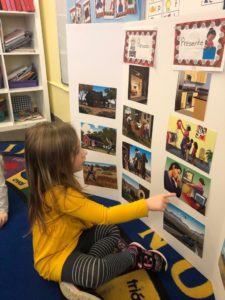 The goal of this unit is that the children will understand that many things they take for granted have not always existed. This prepares them for future cultural history lessons. We looked at a variety of pictures to represent old items. Typical items that I showed them: a candle, the way that people used to have night light; a horse, old schools, houses, television, the ways to deliver the mail, and transportation ways. Also, I showed them pictures of items in our present lives such as streets with asphalt, modern houses, airplanes, trains, communication ways, etc.
The goal of this unit is that the children will understand that many things they take for granted have not always existed. This prepares them for future cultural history lessons. We looked at a variety of pictures to represent old items. Typical items that I showed them: a candle, the way that people used to have night light; a horse, old schools, houses, television, the ways to deliver the mail, and transportation ways. Also, I showed them pictures of items in our present lives such as streets with asphalt, modern houses, airplanes, trains, communication ways, etc.
In our circle time before of our activity I taught kids that before they were born, before their parents were born, before their grandma and grandpa were born…the world was very different. So, I gave them some pictures to show them. Then, they did and activity to guess if children who lived long ago, even before their grandma and grandpa were born, might have had those things (wagon, ink, and old things). They did a great job for our short week of school. I am so glad to see kids participate with this activity.
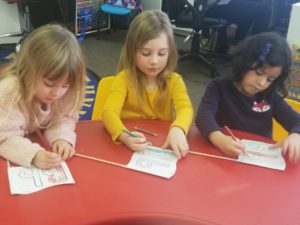 Letras
Letras
This week we went over to the letter B/ letra B. Be sure to point out the letter that we practice when you are reading. The Spanish and English pronunciation of this letter sound are the same.
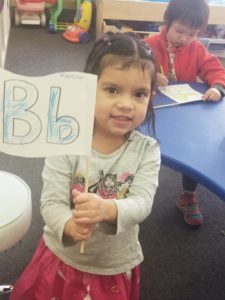 Bolsa – bag or sack,
Bolsa – bag or sack,
Bandera – flag,
Bicicleta – bicycle,
Ballena – whale,
Barco- boat.
Número
This week we co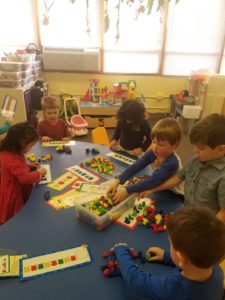 ntinued working with the number 10(diez) doing different activities, as counting and sorting 10 ten/diez little manipulatives. As well, they worked tracing the number 10/número diez on the classroom blackboard.
ntinued working with the number 10(diez) doing different activities, as counting and sorting 10 ten/diez little manipulatives. As well, they worked tracing the number 10/número diez on the classroom blackboard.
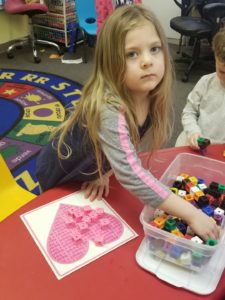 La Figura y Color
La Figura y Color
This month we started working with the corazon/heart shape, a perfect time to see this shape! The kids were playing with the shape, tracing the heart with their fingers. Also, the kids were passing the shape to examine it up close. Also, the kids continued reinforcing the colors names that they learned as rojo/red, azul/blue, verde/green, and amarillo/yellow, cafe/brown, and the new color to learn this month pink/rosado.
Have a good and warm weekend!
by Sarah Segall | Feb 6, 2019 | In The Loop
Spanish With Sarah will have a 2-hour late start due to inclement weather and unsafe road conditions today, Wednesday February 6th.
There will be no AM preschool.
The early-release Wednesday schedule is cancelled. All K-6 classes will now be released at 3:15.
Here is our schedule for our specialist classes for the day:
class 1 10:45-11:45
modified lunch/recess 11:45-12:30
class 2 12:30-1:25
class 3 1:25-2:20
class 4 2:20-3:15
by Sarah Segall | Feb 5, 2019 | In The Loop
SNOW DAY #2
There will be no classes held today at Spanish With Sarah due to the inclement weather.
by Sarah Segall | Feb 5, 2019 | In The Loop
Tomorrow, February 5th, Spanish With Sarah classes will begin two hours late due to inclement weather.
There will be no AM preschool on 2-hour late start days.
by Sarah Segall | Feb 4, 2019 | In The Loop, Preschool
Spanish With Sarah is closed due to inclement weather.
Monday, February 4th.
https://flashalert.net/id/SpanishWithSarah
by Sarah Segall | Feb 2, 2019 | In The Loop
The weather has been really mild this year! However, the forecast is looking questionable for the next week or so. Here’s a reminder on how to stay informed of school delays or cancellations:
We do follow the Camas School District when they choose to have 1-hour and 2-hour late starts and school closures due to inclement weather.
There will be no AM preschool if there is a 2-hour late start.
We will also post this information on the school Facebook page,
In the Loop on the SWS website,
and we will also send out a mass email.
Please be sure to check before you leave home so you don’t trek through unsafe road conditions! Remember, Camas has high elevations that may be unsafe even when things appear fine at your house.
by Ivary & Paola | Feb 1, 2019 | In The Loop
La Lectura
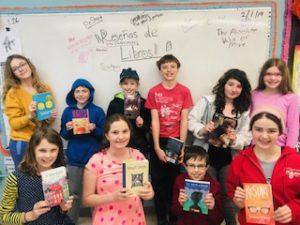 !Celebrado la lectura! This week we celebrated our love for reading (and writing;) by sharing with the class our book reviews. Make sure you ask your child to show you the great pieces they, and their classmates, wrote produced. We have all added some great titles to our reading lists! This week we also continued learning about the life of one of the greatest Latin American writers, Gabriel Garcia Marquez. Since our genre studies focus was biographies, we read about his upbringing and experiences that inspired him to become one of the greatest of Spanish literature. Other objectives included:
!Celebrado la lectura! This week we celebrated our love for reading (and writing;) by sharing with the class our book reviews. Make sure you ask your child to show you the great pieces they, and their classmates, wrote produced. We have all added some great titles to our reading lists! This week we also continued learning about the life of one of the greatest Latin American writers, Gabriel Garcia Marquez. Since our genre studies focus was biographies, we read about his upbringing and experiences that inspired him to become one of the greatest of Spanish literature. Other objectives included:
• Pose and respond to specific questions with elaboration and detail by making comments that contribute to the topic, text, or issue under discussion.
• Cite textual evidence to support analysis of what the text says explicitly as well as inferences drawn from the text.
• Determine a theme or central idea of a text and how it is conveyed through particular details; provide a summary of the text distinct from personal opinions or judgments.
• Analyze in detail how a key individual, event, or idea is introduced, illustrated, and elaborated in a text (e.g., through examples or anecdotes).
• Apply a variety of comprehension and thinking skills while unpacking information from the text (this week’s focus: cause and effect situations)
• Review key characteristics of our genre studies for this week: Biographies.
• With some guidance and support from peers and adults, develop and strengthen writing as needed: final copy, publishing and sharing.
Ciencias
- Explain how adaptations help organisms survive in an environment.
- Describe how population can change over time in response to environmental factors.
Mathematics
This week we wrapped up our unit on algebraic expressions. Our objectives were:
•create and solve expressions from real world problems
•review for the chapter test by completing a classroom Brain Work question
•show what you know on the chapter test
History & Geography
This week we continued learning about the French Revolution. Our objectives were:
•Identify Marie Antoinette and describe her effect on the French people.
•Explain the meaning behind the legendary saying, “then let them eat cake.”
•Describe what happened at the 1789 meeting of the Estates-General.
•Understand Louis XVI’s role in the meeting.
•Understand how the National Assembly came into existence.
Reminder that our field trip to the Pendleton Mill is Thursday February 7th! We will be meeting there at 9 am.
English Writing & Spelling
This week we studied the Greek and Latin roots onym, host, hosp. All these roots have something to do with people!
We also worked on building a conclusion in our argumentative writing.
Specialists
Music with Ms. Erin
In January we learned the Italian terms for tempos from grave (very, very slow), to prestissimo (extremely fast). We practiced rhythm reading by clapping written rhythm patterns to these tempos. We learned about musical form, adding introduction, interlude, and coda to our knowledge base of verse, chorus (refrain), and bridge. We also started learning about Harlem Renaissance music.
In February we will be working on reading notation in the treble and bass clefs, and introducing the skill of sight singing. We will identify, write, read, sing, and play music from written notation using a variety of musical styles. We will learn about jazz, continuing our study of the Harlem Renaissance, by using lead sheets and singing popular jazz songs.
Art with Ms. Kelly
We worked on 2 projects in January:
Art Project: Cakes in the style of Wayne Thiebaud
Book and Website: Artwork by Wayne Thiebaud
Goals:
- Learn about the artist, Wayne Thiebaud (who is still painting at age 98!)
- Observe light and dark shapes, and shadows
- Draw a cylinder with a wedge cut out
- Use oil pastels to create shading and shadows
I’m sure you’ve enjoyed these beautiful cakes on the bulletin board at school!
Art Project: Figures in the style of Jacob Lawrence
Books: Jake Makes a World by Sharifa Rhodes-Pitt,
Story Painter: The Life of Jacob Lawrence
Goals:
- Learn about Jacob Lawrence, an African American artist
- (who grew up in Harlem but moved to Seattle and taught art at University of Washington)
- Use basic shapes to draw students at the blackboard
- Use tempera paint for the background and figures in your artwork
These awesome pictures are on the bulletin board at the end of the hallway!
by Sarah Segall | Feb 1, 2019 | In The Loop
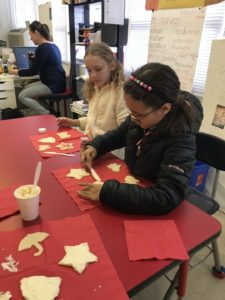
Photo credit: Kate
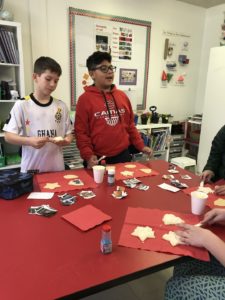
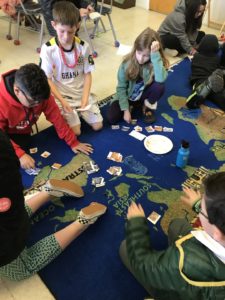
Fun celebrating the end of our Africa unit playing a game Eli designed.
History & Geography
Our weekly objectives were to:
- Understand China´s isolation and why the Chinese finally tried to break that isolation.
- Identify the reasons for the development of the Silk Road.
- Relate the idea of the Han dynasty as a golden time to cultural advances such as the invention of paper.
- Describe the social and personal pressures facing young women in ancient China.
- Identify details that reveal Changan to have been a bustling, diverse, exotic capital.
- Recognize Wu Zhaoś extraordinary rise to political power form humble beginnings.
Newsletter by Pierce:
On Monday in English we had our African celebration!
On Tuesday in Science we had to redo our test!
On Wednesday it was wackey!
On Thursday we brought our science information.
On Friday it is BINGO DAY!
Mathematics w/Laura
Adding and Subtracting Decimals
- Adding and Subtracting Decimals
- Real World Problems: Decimals
- Review and Put on Your Thinking Caps
- Chapter 8 assessment on Tuesday, February 5th
Puzzles available for extra credit and Friday (Math) Bingo
Remember: MATH …. It’s everywhere
La lectura
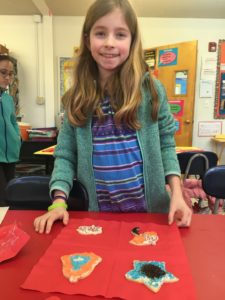 This week we read a very fun folktale: La Sal. This Russian tale is about three sons. The third son, Ivan, is called a fool but is a good, wise, and clever man. When faced with problems, Ivan does not resort to treachery or wickedness as his brothers do. By strumming sweet melodies on his mandolin, he charms a gloomy giant, woos a princess, and wins back the riches stolen from him by his two jealous brothers.
This week we read a very fun folktale: La Sal. This Russian tale is about three sons. The third son, Ivan, is called a fool but is a good, wise, and clever man. When faced with problems, Ivan does not resort to treachery or wickedness as his brothers do. By strumming sweet melodies on his mandolin, he charms a gloomy giant, woos a princess, and wins back the riches stolen from him by his two jealous brothers.
Our weekly objectives were to:
- identify the authorś point of view
- identify the common folktale moral (in this case: goodness wins over evil)
- work together to turn the story into a short skit, creating dialogue. (We will really dig into this next week.)
- identify digraphs, which are two letters that make one sound (our spelling list this week was full of digraphs- ll, rr, ch)
- review use of semicolons, colons, and other marks. (Colons are used to present a list of things, before quotation marks, and after the greeting in a letter. Semicolons are used to separate the components of a long series that contains commas. Parentheses are used around words that add information to, or clarify, a sentences. Hyphens separate some compound words.)
On Monday we celebrated a combined reading for December and January with a cookie decorating party after lunch. Yumm!!
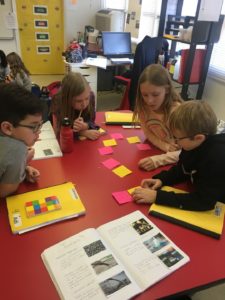
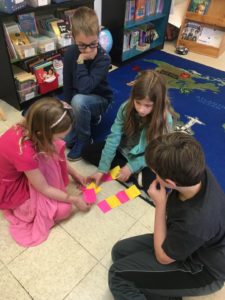 Ciencias
Ciencias
Students were given the opportunity to retake their science test (since I was absent on the day it was given). I was supposed to hand them back (but neglected to do so). They will receive them on Monday.
We began our new science topic: Natural Resources. We reviewed what we have learned about soils, rocks, and landforms. Students worked in groups to create a concept map to bring these ideas together. We focused on earth materials as renewable and nonrenewable natural resources by viewing and discussing a video.
We also read, as a whole class, about monuments around the world. It was interesting to compare and contrast theses 4 monuments in a graphic organizer. The Washington Memorial, The Vietnam Veterans Memorial, The Taj Mahal, The Great Pyramid. What were they made out of? Who were they made for? How long did construction take?
Our focus question this week was: What are natural resources and what is important to know about them?
Specialists:
Music with Ms. Erin
In January we learned about musical form; verse, chorus (refrain), introduction, and coda. We learned about theme and variations by studying the music of W. A. Mozart, J. S. Bach, and Liszt’s variations on a theme by Paganini.
In February we will be working on reading notation in the treble and bass clefs, and introducing the skill of sight singing. We will identify, write, read, sing, and play music from written notation using a variety of musical styles. We will learn about jazz and the Harlem Renaissance, while being introduced to jazz “lead sheets”.
Art with Ms. Kelly
We worked on 2 projects in January:
Art Project: Cakes in the style of Wayne Thiebaud
Book and Website: Artwork by Wayne Thiebaud
Goals:
- Learn about the artist, Wayne Thiebaud (who is still painting at age 98!)
- Observe light and dark shapes, and shadows
- Draw a cylinder with a wedge cut out
- Use oil pastels to create shading and shadows
I’m sure you’ve enjoyed these beautiful cakes on the bulletin board at school!
Art Project: Figures in the style of Jacob Lawrence
Book: Jacob Lawrence
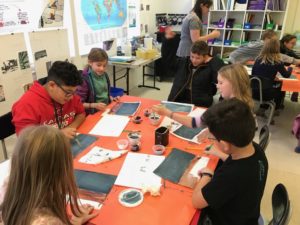 Goals:
Goals:
- Learn about Jacob Lawrence, an African American artist
- (who grew up in Harlem but moved to Seattle and taught art at University of Washington)
- Use basic shapes to draw students at the blackboard
- Use tempera paint for the background and figures in your artwork
We are still working on this project, and I plan to display them on a bulletin board in February.
by Jill & Sarah | Feb 1, 2019 | In The Loop
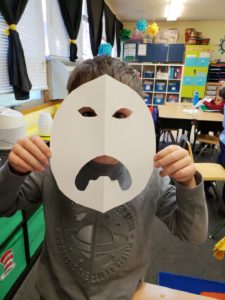 History & Geography
History & Geography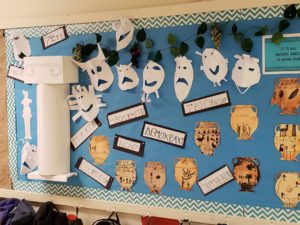
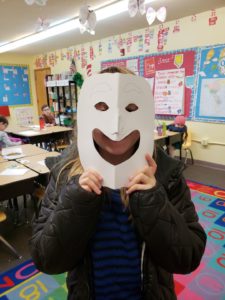
In our studies of Ancient Greece this week we learned about the great thinkers of Greece, Plato, Socrates, and Aristotle. We talked about Greek chorus and acted out some Aesop’s fables. The students made tragedy and comedy marks. On Friday we played jeopardy and reviewed for our assessment next week.
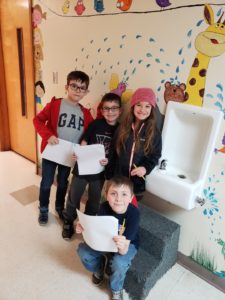 Our objectives:
Our objectives:
• identify Socrates, Plato, and Aristotle as great philosophers of ancient Greece
• understand how ideas can spread through writing and teaching
• identify Alexander the Great
• indicate on a map that area Alexander the Great conquered
• listen to a variety of Aesop’s Fables
•act out fables as part of a Greek Chorus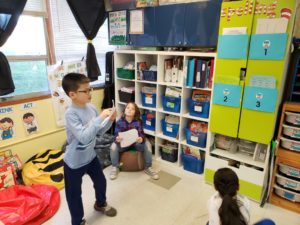
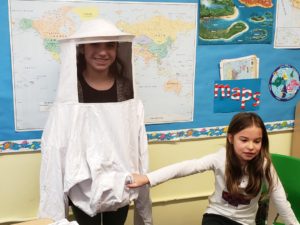 Science
Science
This week we took a pausing point and reviewed what we’ve learned so far about the interesting world of insects. We watched a film on Wednesday about insects and wrote more in our insect journals. On Friday we began learning about social insects, ants and termites.
Our objectives were to:
• explain that insects are the largest group of animals on Earth
• explain that there are many varieties of insects
• identify and describe three main body parts of insects: head, thorax, abdomen
• identify the placement and / or purpose of an insect’s body parts
• distinguish between social and solitary insects
• explain that most insects live solitary lives but some such as ants and termites, are social
• describe how all members of a social insect colony come from one queen
• describe the social behavior of ants and ant colonies
• describe the roles of worker ants, males, and queens
English Spelling and Writing
In our journals we used the idiom of the week, I stuck my foot in my mouth. The class worked on two sort activities this week to prepare for their final spelling test on Friday. Several students also took a Word Wall test this week. Our Word Wall words were: one, old, or, outside.
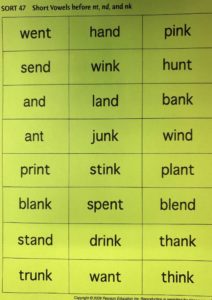
Green spelling sort
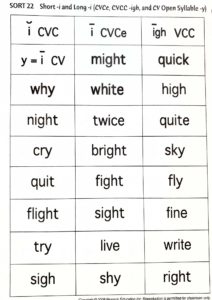
Blue spelling sort
La lectura
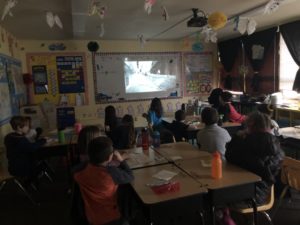
This week we read Todos Creyeron que lo habían visto.
Our weekly objectives were to:
- Understand the story vocabulary
- review asking questions during our first read
- during our second read use the comprehension skill making conclusions
- practice finding linking and helping verbs within sentences
Las matemáticas
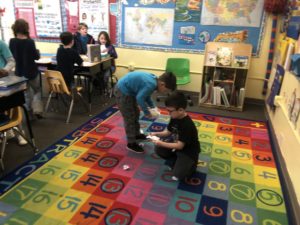 This week we wrapped up our unit on Volume. Our weekly objectives were to:
This week we wrapped up our unit on Volume. Our weekly objectives were to:
- Practice reading the number of liters on a marked container
- apply knowledge to real world volume problems
- review for the test by playing snowball toss
- show what we know on the chapter test
Specialists:
Art with Ms. Kelly
The students did a wonderful job with 2 challenging art projects this month.
Art Project: Make a Winter Landscape with Animals, using collage technique
Book: “Over and Under the Snow” by Kate Messner, with art by Christopher Silas Neal
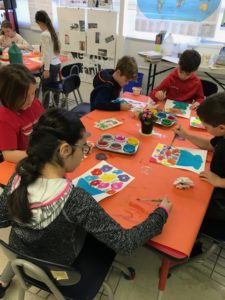 Goals:
Goals:
- Observe illustrations in book, especially close-up and far away trees
- Learn about forest animals in winter
- Practice drawing a fox using geometrical shapes
- Cut out basic shapes to make a red fox, a mouse, and a deer
- Cut out shapes to make trees, and add texture with crayon
Art Project: Folk Art Flowers
Book: Art From Her Heart, Folk Artist Clementine Hunter by Kathy Whitehead
Goals:
- Learn about Clementine Hunter, an African American folk art painter
- Draw a bowl or vase with crayon, and add simple flower shapes to fill page
- Paint with tempera paint
I hope to display these beautiful flower paintings on the bulletin board in February!
Music with Ms. Erin
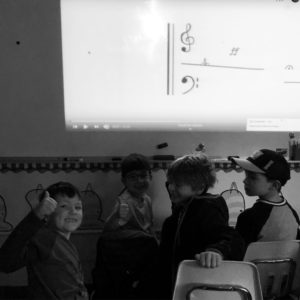 In January we learned about fast and slow tempos, speeding up and slowing down within a musical piece, reviewed forte and piano dynamics, and learned how to draw the treble and bass clefs. We also listened to music by composers Grieg, Beethoven, and Vivaldi.
In January we learned about fast and slow tempos, speeding up and slowing down within a musical piece, reviewed forte and piano dynamics, and learned how to draw the treble and bass clefs. We also listened to music by composers Grieg, Beethoven, and Vivaldi.
In February we will be learning about the letter-name notes in the C major scale, and the names of the notes on the treble staff. We will learn how to draw the rests that correspond with our previously learned notes: whole note (4 beats), half note (2 beats), and quarter note (1 beat). We will be singing and playing notes while reading them on the staff.
by Sarah Segall | Feb 1, 2019 | In The Loop
Project: We will be celebrating the 100th day of school on Thursday, February 14th. This is a BIG day for us! We have been working on counting up to 100 since the first day of school! Please help your child to design a Valentine box that contains 100 of any item. (100 stickers, 100 beads glued on, 100 hearts, 100 buttons, 100 wiggly eyes, 100 of anything! You could even do 10 groups of 10!)
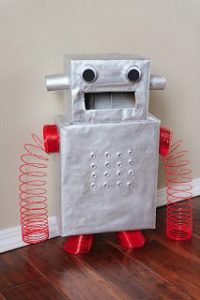
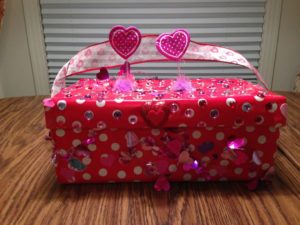
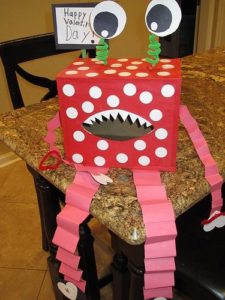
La lectura
This week we completed our Wind unit. A few of the stories we read this week were Tormenta de Nieve and Feriado. The students especially enjoyed listening for all the rhyming words in Feriado.
I have been very impressed with how the students are doing during our word of the day. I always ask for volunteers to use the word in a sentence. Typically every student provides at least one sentence. Their Spanish word of the day is written in their planners. They are pretty close to reaching 1000 tallies (which earns them a piñata)!
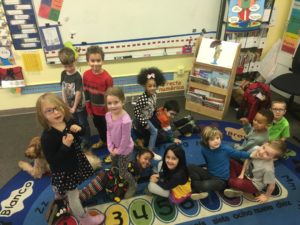
delante de (in front), detrás (behind), debajo (under), al lado de (next to), encima (on top of)
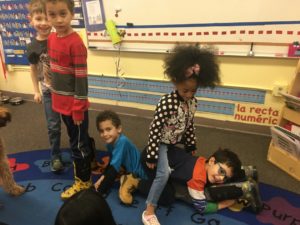 We also started working on prepositions, words that show location. This was very fun! We rolled a pictorial die and drew names sticks to have students put their whole body in certain locations/positions. We will continue to work on this for ….ever!
We also started working on prepositions, words that show location. This was very fun! We rolled a pictorial die and drew names sticks to have students put their whole body in certain locations/positions. We will continue to work on this for ….ever!
All students received a new reader this week (some received 2). Please remember to have your child read to you each night (and to read to them!). They should mark off their treasure sheet each time they read a book. They should read their new books and then can go back and read older books too. These reading binders should go home and come back to school each day please! Students are always bummed when it’s time to read and they have forgotten their books at home.
Please look for an email regarding our upcoming Valentine’s Day and 100th Day celebrations.
Las matemáticas
This week we focused on composing and decomposing the number 16. The students all did a great job using their two sided circles as a visual representation, as well as using number bonds/ números conectados and equations.
We started looking at how numbers work together and form number families. (3+5 is the same as 5+3) We also started talking about subtraction. (8-3 is 5 and 8-5 is 3).
These activities are part of our operations & algebraic thinking and help us to better understand addition and subtraction.
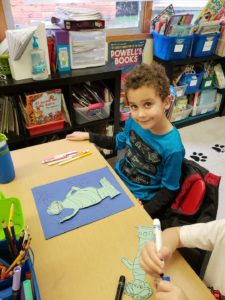 History & Geography
History & Geography
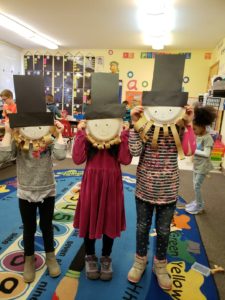
Abraham Lincoln
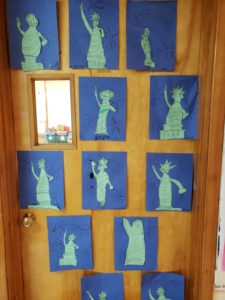
Our objectives this week were to:
• recognize Abraham Lincoln as an important president of the United States •identify that Abraham Lincoln was known as Honest Abe
• recall information about Abraham Lincoln’s younger life
• identify the Emancipation Proclamation and how this affected our country.
• recognize Theodore Roosevelt as an important president of the United States
• know that Theodore Roosevelt overcame childhood health problems
• know that Theodore Roosevelt loved the outdoors
• know that Theodore Roosevelt worked for nature conservation
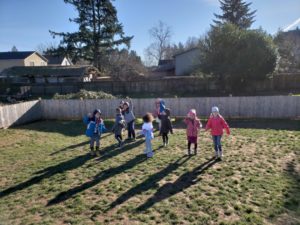
Playing outdoors
Science
This week we learned about seasonal activities and sports and how these help us feel less cooped up. We also read about severe weather and how we protect ourselves by using proper gear and practicing safe behavior. Students did an interactive drawing activity with a partner, showing severe weather and ways they can protect themselves. They then shared these pictures with the rest of the class.
Our objectives were to:
• describe any unique seasonal differences that are characteristic of our own locality
• Identify the four seasons and activities that are associated with those seasons
• identify the following characteristics of thunderstorms: heavy rain, thunder, lightning, and strong winds
• identify and describe different types of severe weather
• describe safe and unsafe behaviors during severe weather
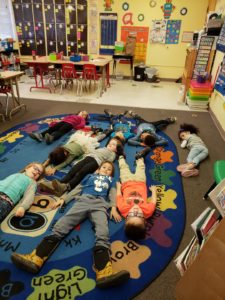
What to do in a thunderstorm if you can’t get to shelter.
Specialists: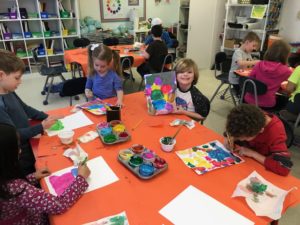
Art with Ms. Kelly
K/1 Class
The students did a wonderful job on 2 challenging projects in January:
Art Project: Make a Winter Landscape with Animals, using collage technique
Book: “Over and Under the Snow” by Kate Messner, with art by Christopher Silas Neal
Goals:
- Observe illustrations in the book, especially close-up and far away trees
- Learn about forest animals in winter
- Cut out geometrical shapes to make a red fox and a mouse
- Cut out shapes to make trees, and add texture with crayon
Art Project: Folk Art Flowers
Book: Art From Her Heart, Folk Artist Clementine Hunter, by Kathy Whitehead
Goals:
- Learn about Clementine Hunter, an African American folk art painter
- Draw a bowl or vase with crayon, and add flowers to fill page
- Paint with tempera paint
VOLUNTEERS: There is room and need for 2 parent volunteers each week in Art. The sign-up sheet is still on the bulletin board by the office.
 The goal of this unit is that the children will understand that many things they take for granted have not always existed. This prepares them for future cultural history lessons. We looked at a variety of pictures to represent old items. Typical items that I showed them: a candle, the way that people used to have night light; a horse, old schools, houses, television, the ways to deliver the mail, and transportation ways. Also, I showed them pictures of items in our present lives such as streets with asphalt, modern houses, airplanes, trains, communication ways, etc.
The goal of this unit is that the children will understand that many things they take for granted have not always existed. This prepares them for future cultural history lessons. We looked at a variety of pictures to represent old items. Typical items that I showed them: a candle, the way that people used to have night light; a horse, old schools, houses, television, the ways to deliver the mail, and transportation ways. Also, I showed them pictures of items in our present lives such as streets with asphalt, modern houses, airplanes, trains, communication ways, etc. ntinued working with the number 10(diez) doing different activities, as counting and sorting 10 ten/diez little manipulatives. As well, they worked tracing the number 10/número diez on the classroom blackboard.
ntinued working with the number 10(diez) doing different activities, as counting and sorting 10 ten/diez little manipulatives. As well, they worked tracing the number 10/número diez on the classroom blackboard.

































